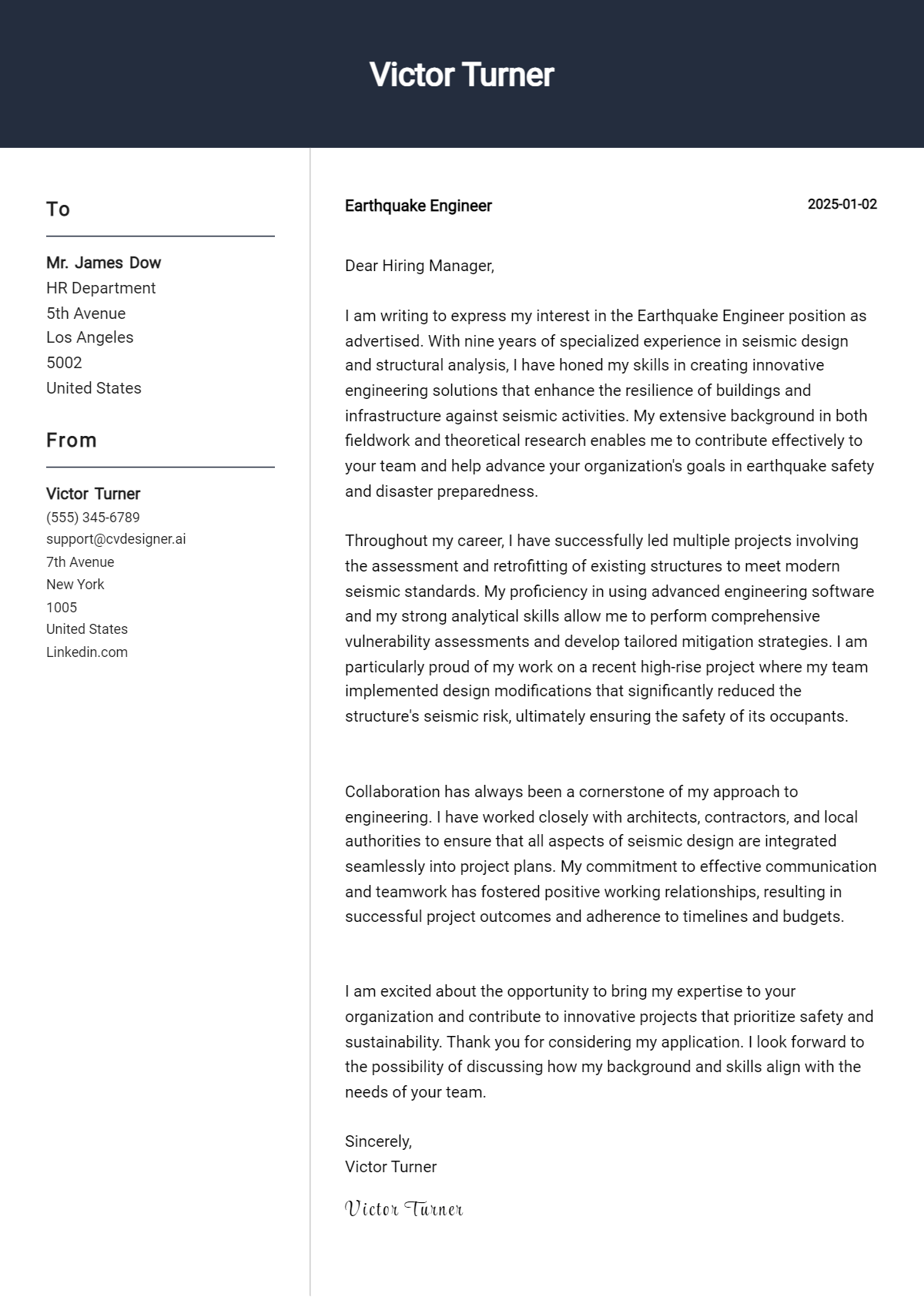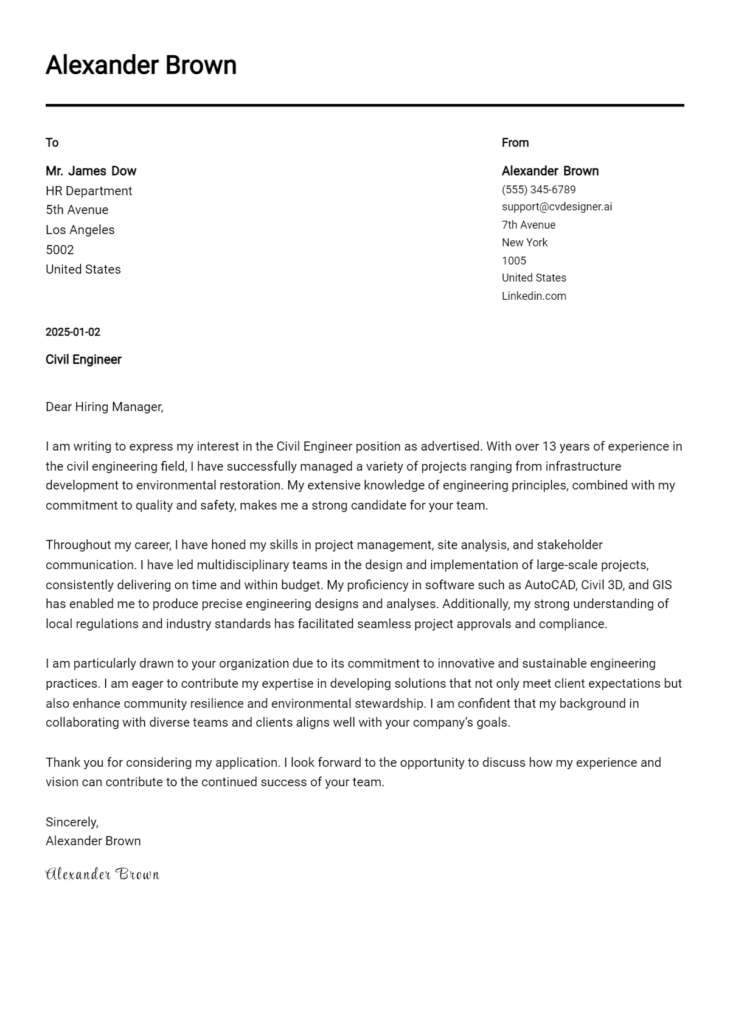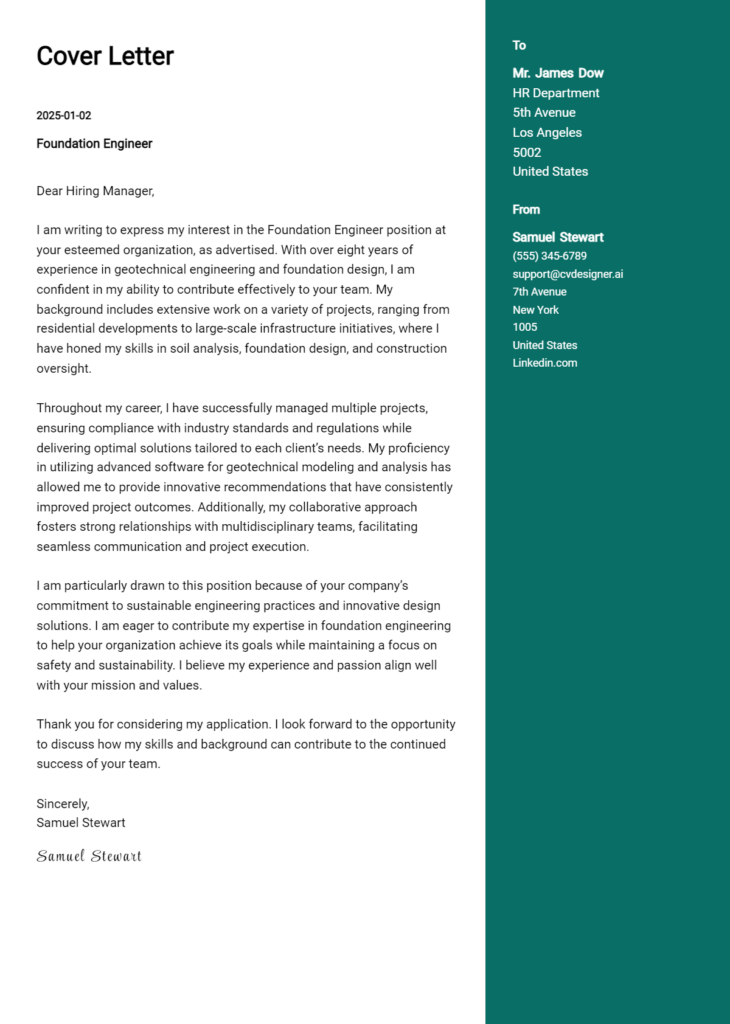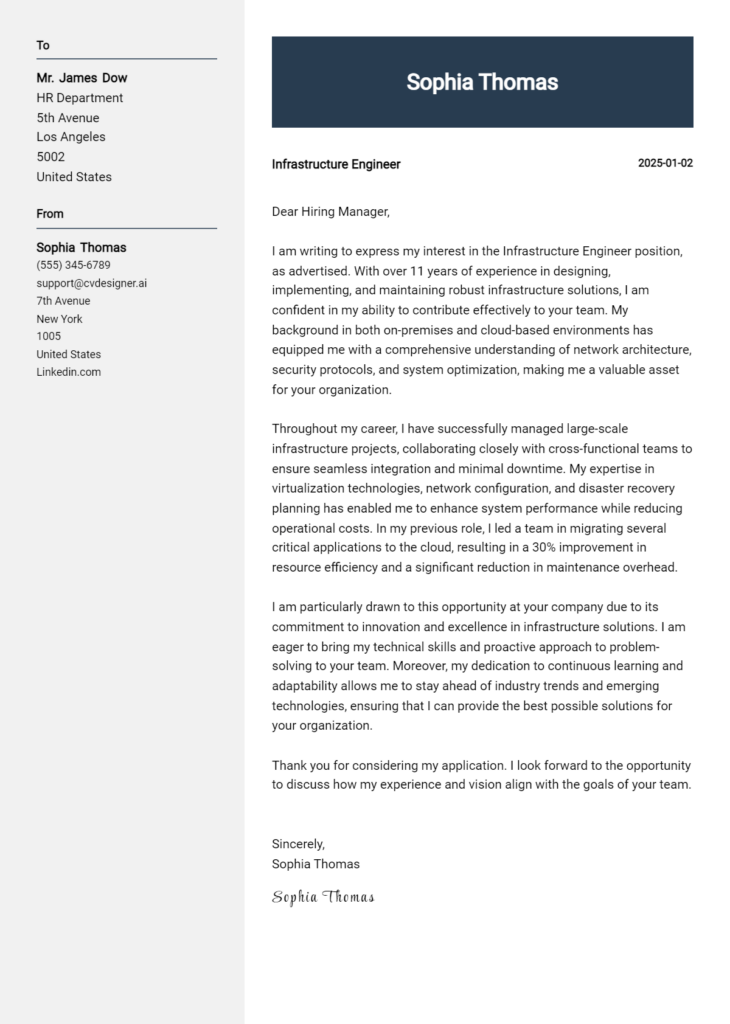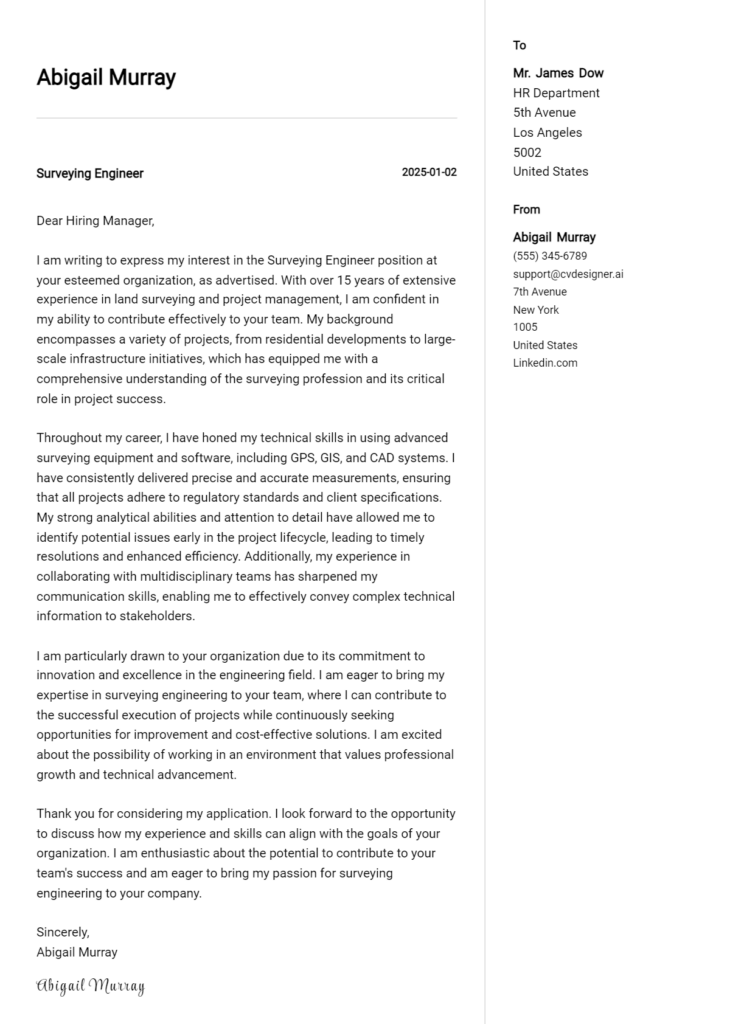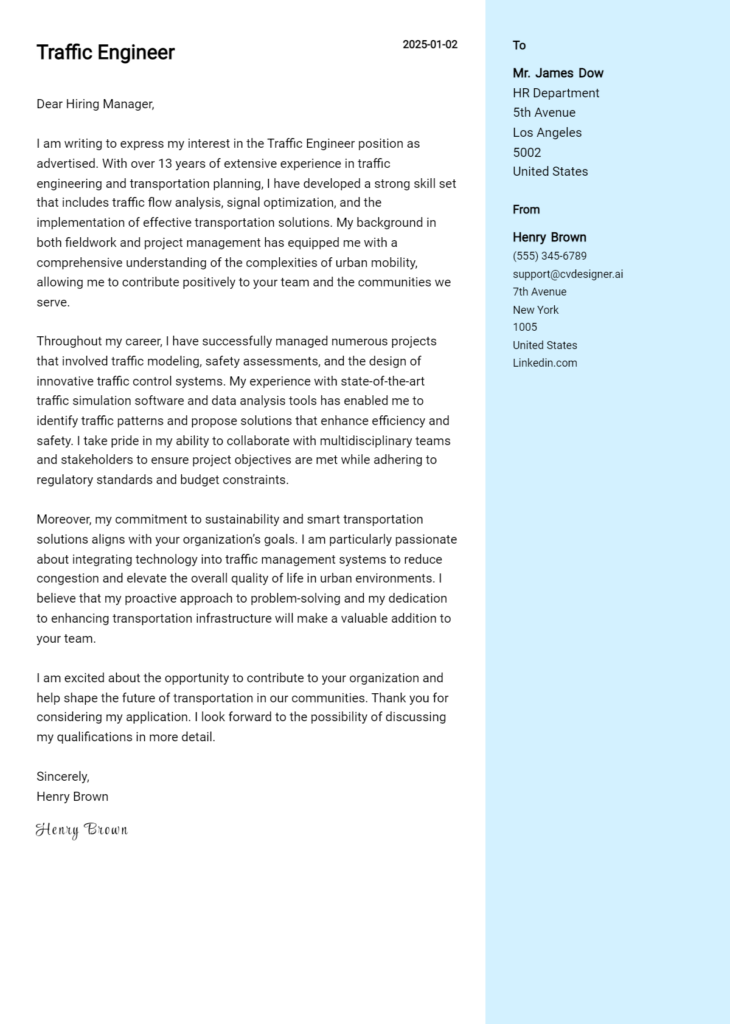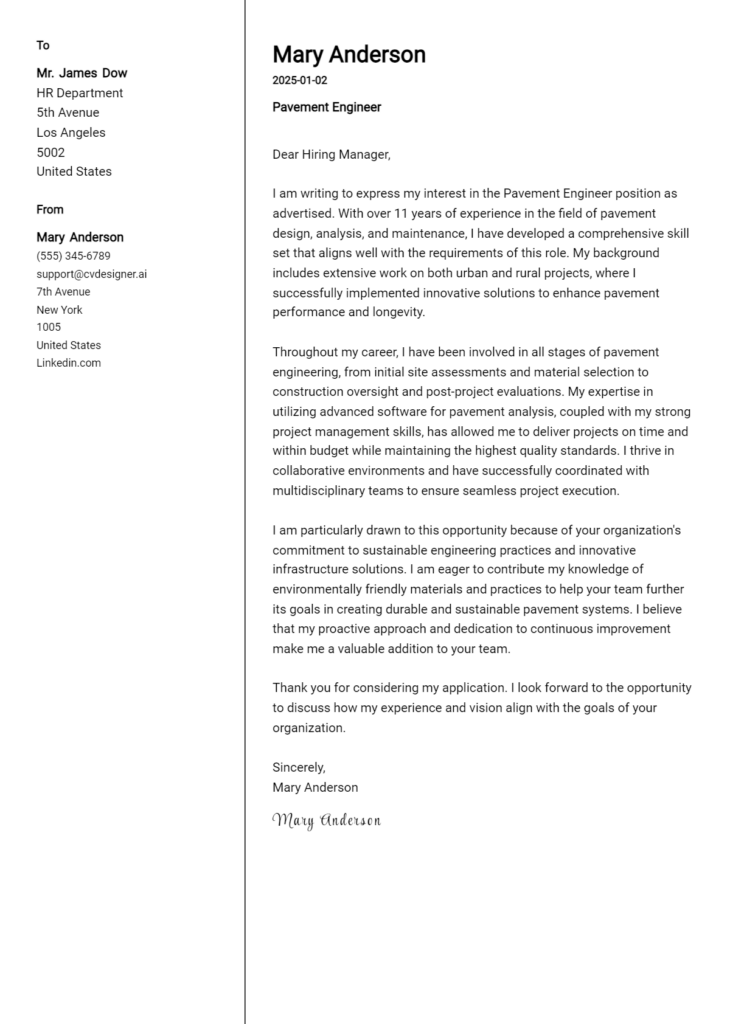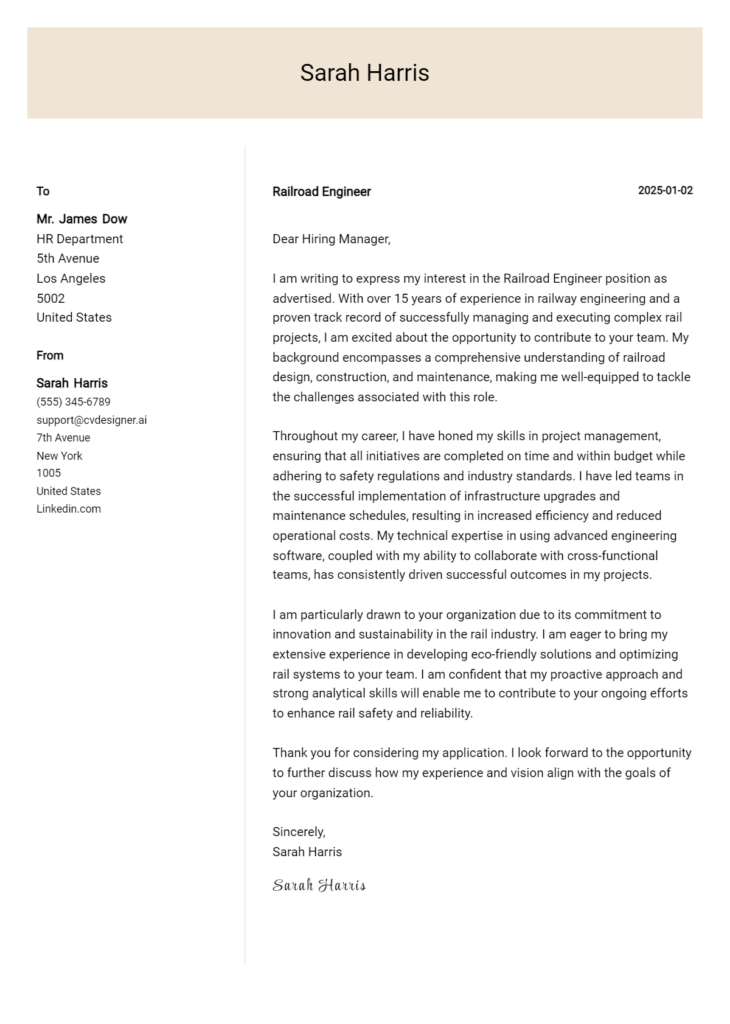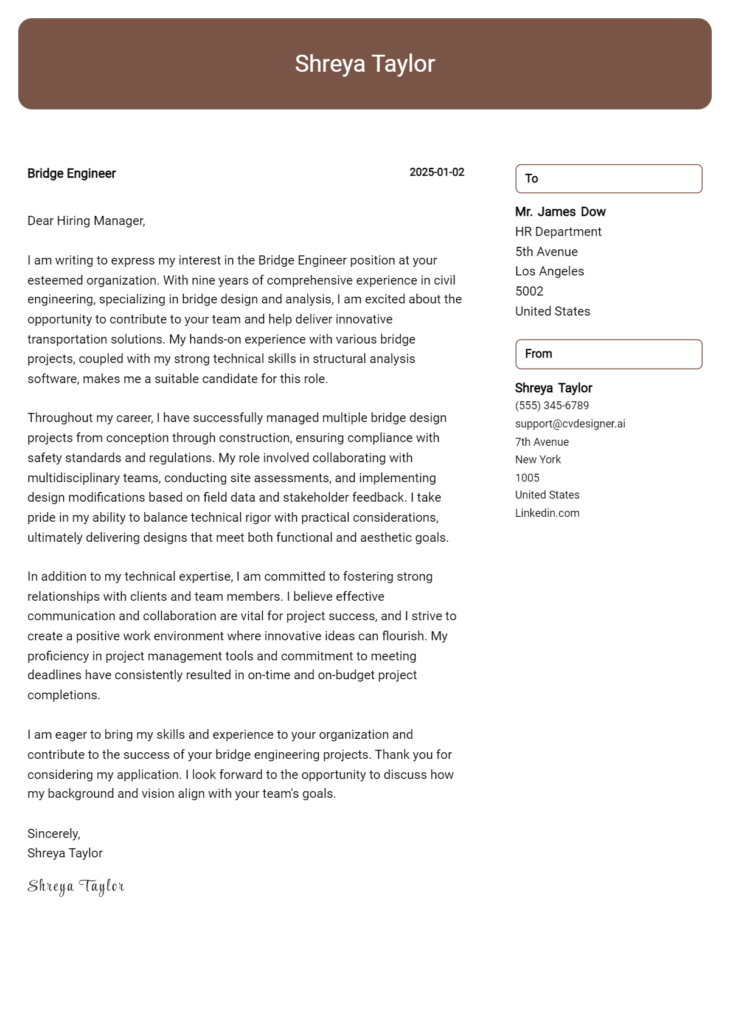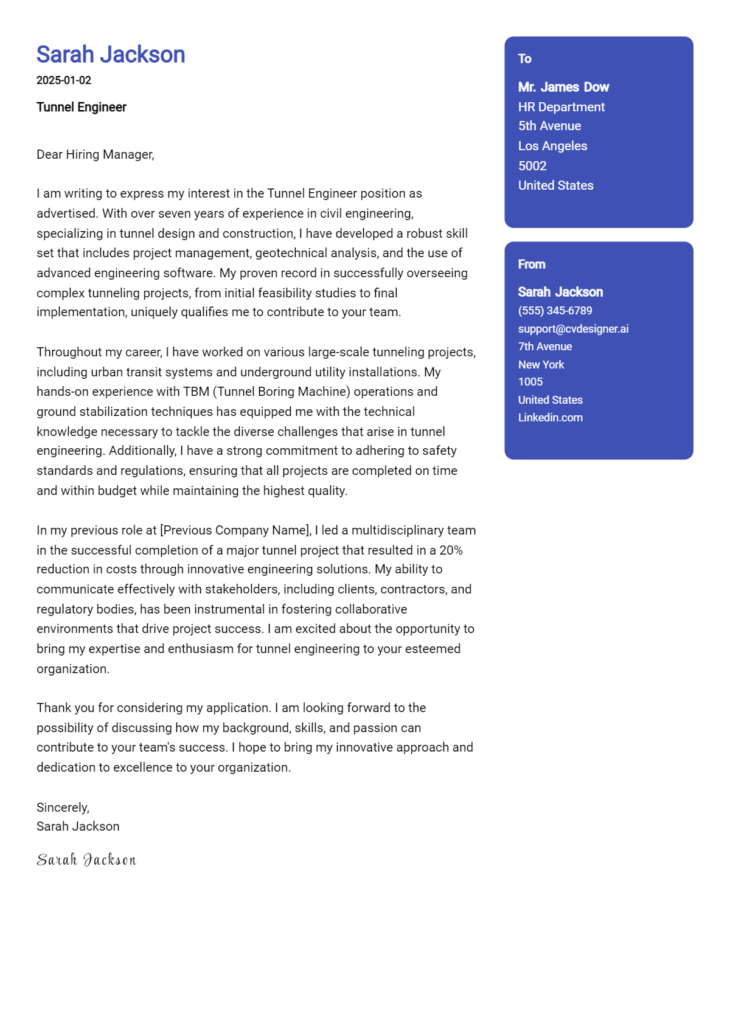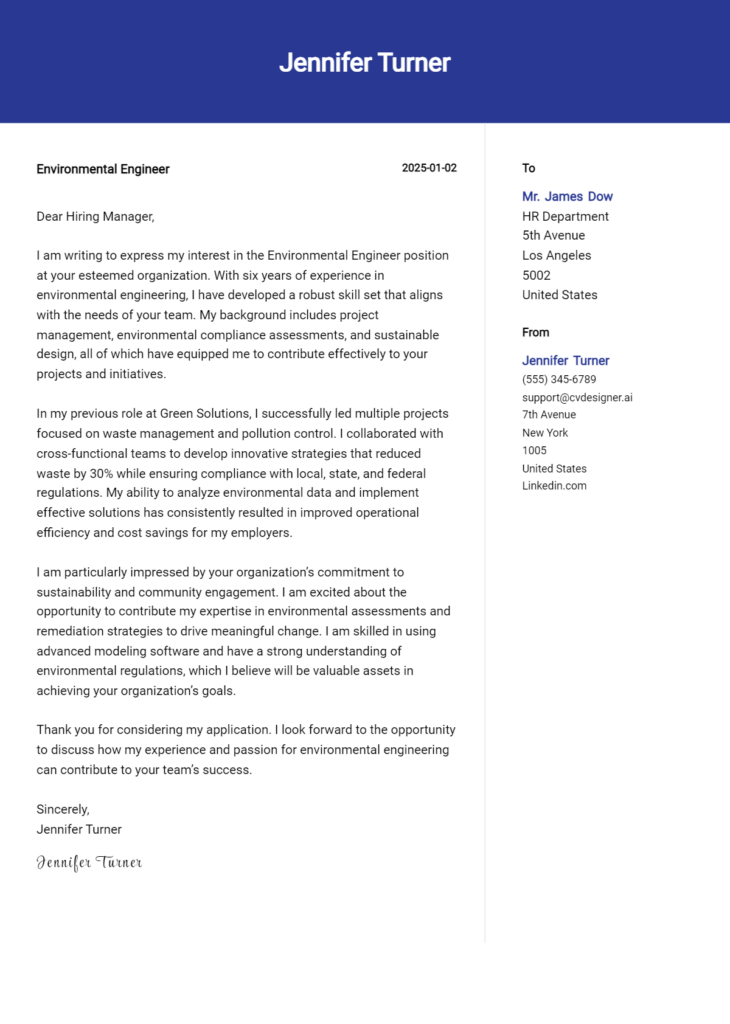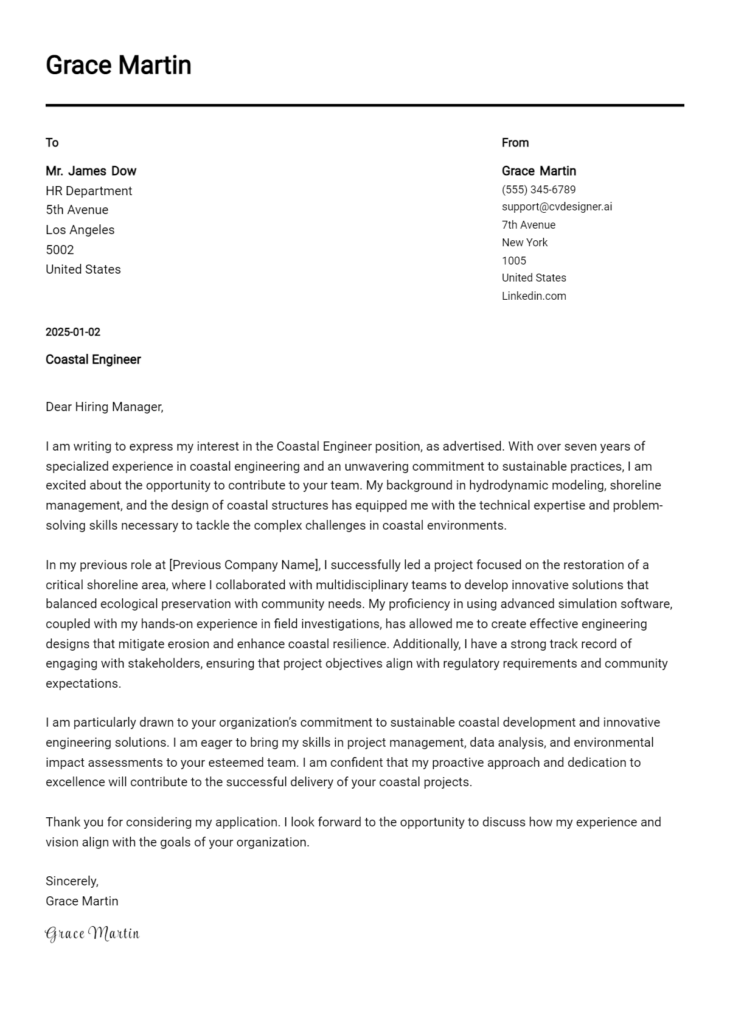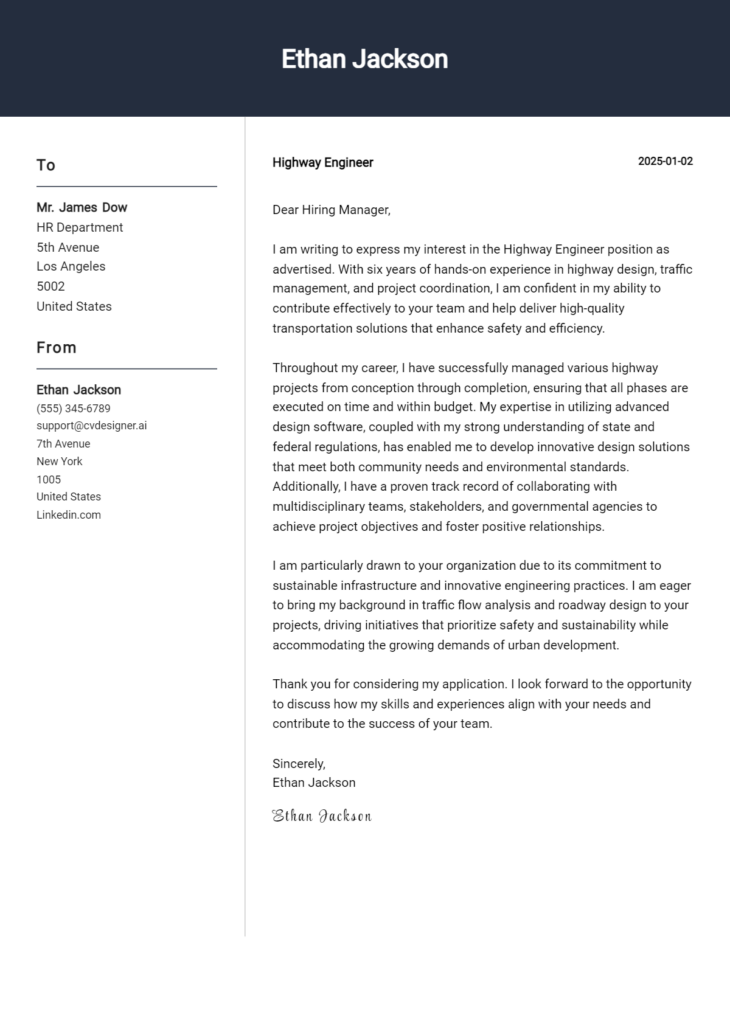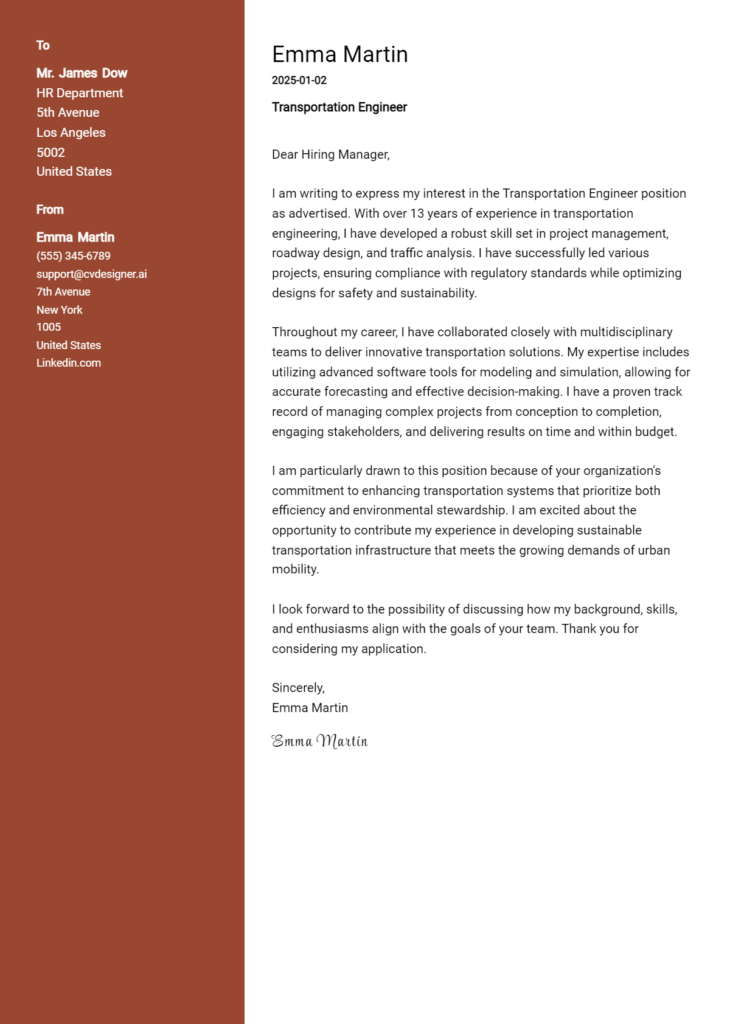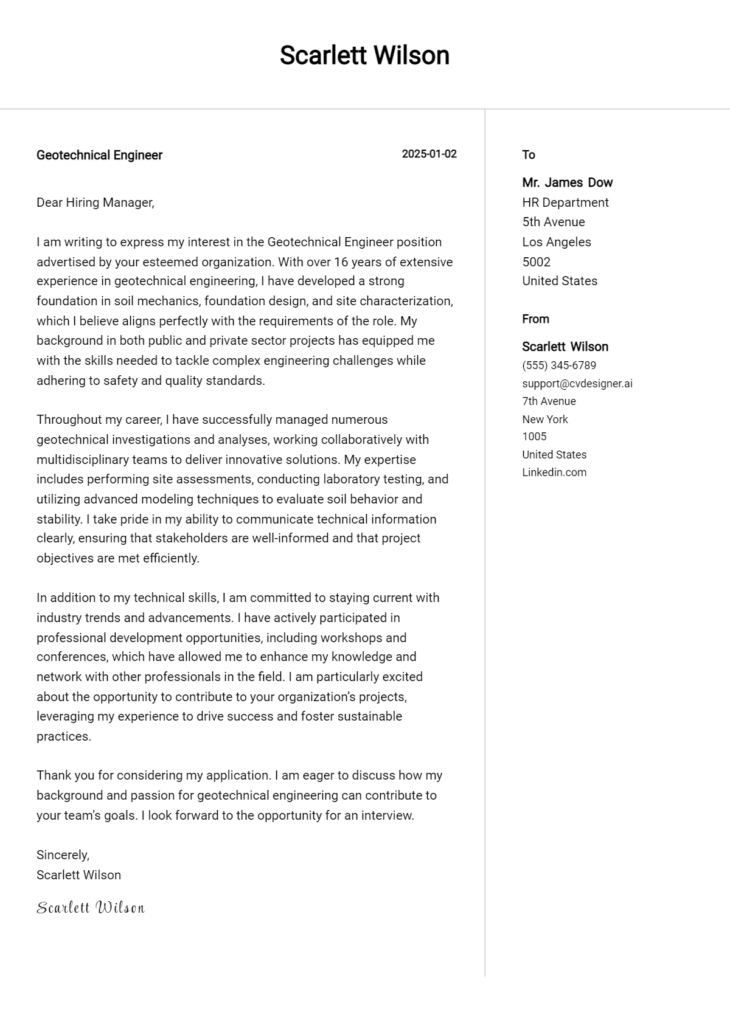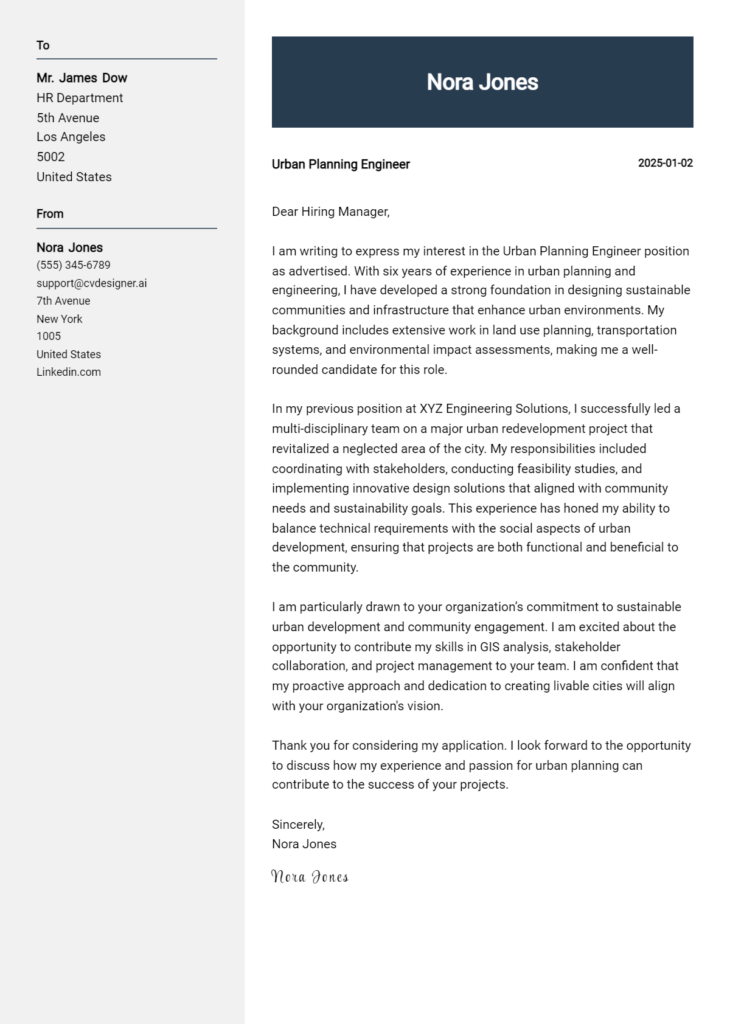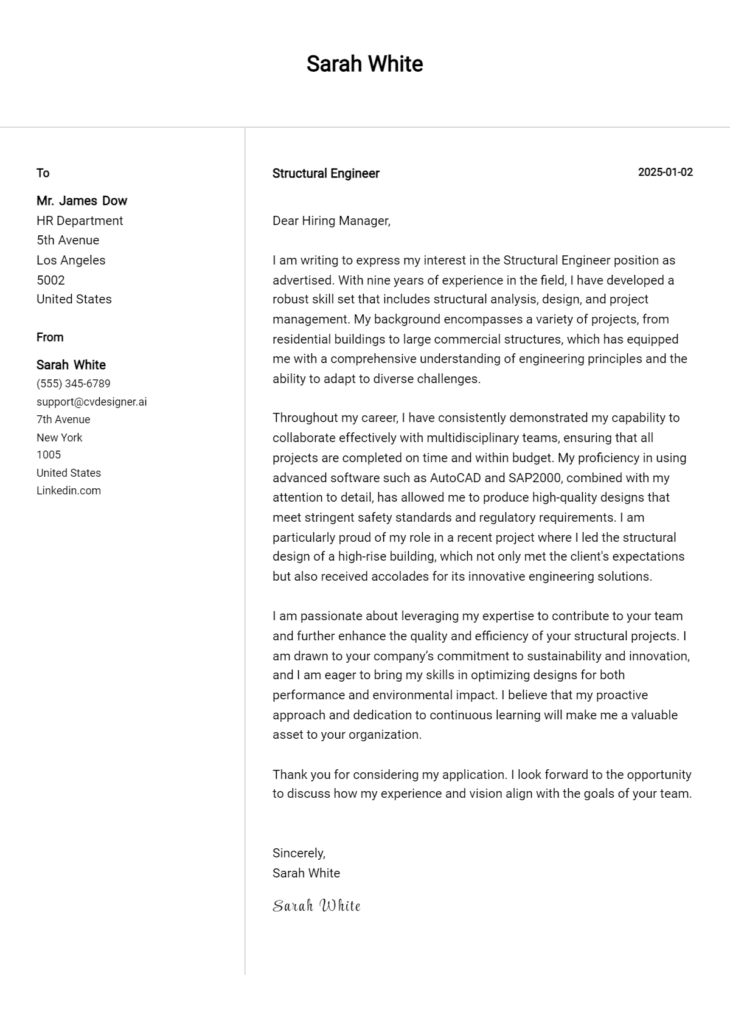Earthquake Engineer Cover Letter Examples
Explore additional Earthquake Engineer cover letter samples and guides and see what works for your level of experience or role.
How to Format an Earthquake Engineer Cover Letter
Crafting a compelling cover letter for an Earthquake Engineer position is essential, as it provides an opportunity to demonstrate not only your technical expertise but also your commitment to safety and innovation in the field. Proper formatting is crucial, as it reflects your organizational skills and attention to detail—qualities that are vital when dealing with the complexities of seismic engineering. A well-structured cover letter captures the hiring manager's attention and sets the tone for your application.
In this guide, we’ll explore how to structure your cover letter effectively, offering insights and examples tailored for earthquake engineering roles to help you create a persuasive document.
We will focus on the key components of a professional cover letter, including:
- Cover Letter Header
- Cover Letter Greeting
- Cover Letter Introduction
- Cover Letter Body
- Cover Letter Closing
Each section is important for showcasing your qualifications and professionalism in the field of earthquake engineering. Let’s delve into each part and discuss how to make your cover letter stand out.
Importance of the Cover Letter Header for an Earthquake Engineer
The cover letter header is a crucial component of your application as an Earthquake Engineer, setting the tone for the entire document. It provides essential information that establishes your identity and contact details, allowing the recipient to easily reach out to you. The header should include your name, address, phone number, email, the date, and the recipient's name and address. Clarity and professionalism are paramount; a well-structured header conveys attention to detail and respect for the hiring process, while a poorly constructed one can diminish your credibility.
Here are examples of a strong and weak cover letter header for an Earthquake Engineer:
Strong Example
John Doe 123 Seismic Lane Earthquake City, CA 90210 (123) 456-7890 johndoe@email.com October 1, 2023 Dr. Jane Smith Head of Engineering Department Seismic Solutions Inc. 456 Fault Line Road Earthquake City, CA 90210
Weak Example
johndoe@email.com October 1, 2023 Seismic Solutions Inc.
The Importance of the Cover Letter Greeting for an Earthquake Engineer
The greeting of a cover letter serves as the first impression for a potential employer and plays a crucial role in setting the tone for the rest of the letter. By addressing the hiring manager directly, you demonstrate professionalism and a personal touch that can distinguish you from other candidates. A well-crafted greeting shows that you value the opportunity and have taken the time to research the organization and its personnel. Avoiding generic greetings, like "To Whom It May Concern," enhances your credibility and helps establish a connection with the reader. If the recipient's name isn't readily available, a quick search or call to the company can yield valuable information.
Here are examples of strong and weak greetings for an Earthquake Engineer cover letter:
Strong Greeting Example
Dear Dr. Smith,
Weak Greeting Example
To Whom It May Concern,
Importance of a Well-Crafted Cover Letter Introduction for an Earthquake Engineer
A well-crafted cover letter introduction is crucial for any Earthquake Engineer looking to make a lasting impression on a hiring manager. This opening paragraph serves as the first point of contact and should effectively capture the reader's attention, express genuine interest in the role, and succinctly highlight key skills or achievements relevant to earthquake engineering. An engaging introduction sets the tone for the rest of the cover letter and can significantly impact the candidate's chances of being invited for an interview. Below are examples of strong and weak cover letter introductions for an Earthquake Engineer.
Strong Example
Dear [Hiring Manager's Name], As a dedicated Earthquake Engineer with over five years of experience in seismic risk assessment and structural design, I am excited to apply for the Earthquake Engineer position at [Company Name]. My background in developing innovative solutions for earthquake-resistant buildings has not only improved safety standards but also enhanced community resilience. I am particularly drawn to your mission of creating sustainable infrastructure, and I am eager to contribute my expertise to your esteemed team.
Weak Example
To whom it may concern, I am writing to apply for the Earthquake Engineer position. I have a degree in civil engineering and some experience in the field. I hope to get a job at your company because it seems interesting.
Purpose of the Cover Letter Body for an Earthquake Engineer
The cover letter body for an Earthquake Engineer serves as a vital platform for candidates to articulate their specialized skills, relevant experiences, and the unique value they can bring to the prospective employer. This section allows the applicant to highlight specific projects that demonstrate their expertise in seismic design, risk assessment, and structural analysis. By providing concrete examples of past accomplishments, such as successful mitigation strategies implemented in high-risk areas or innovative design solutions that enhanced building resilience, candidates can effectively illustrate their proficiency in addressing the challenges posed by earthquakes. This targeted approach not only showcases their technical capabilities but also aligns their professional narrative with the company’s mission and goals.
Strong Example
Dear Hiring Manager, I am excited to apply for the Earthquake Engineer position at ABC Engineering. With over five years of experience in seismic analysis and retrofitting, I have successfully led several projects that enhanced building resilience against earthquakes. For instance, I spearheaded a retrofitting project for a 20-story commercial building in San Francisco, where my team and I implemented innovative base isolation techniques that reduced seismic forces by over 40%. Additionally, my work on the structural assessment of critical infrastructure post-earthquake in Haiti not only reinforced my technical skills but also deepened my commitment to developing safer communities. I am eager to bring my expertise in seismic design and my passion for disaster resilience to ABC Engineering. Sincerely, [Your Name]
Weak Example
Dear Hiring Manager, I am writing to express my interest in the Earthquake Engineer position. I have some experience in engineering and have worked on projects related to buildings. I think I can do a good job for your company. I once worked on a building project that had some earthquake considerations, but I do not remember the details. I believe I would be a good fit for the position because I like engineering. Best, [Your Name]
Importance of the Cover Letter Closing for an Earthquake Engineer
The closing paragraph of a cover letter is crucial as it serves to summarize your qualifications, express your enthusiasm for the Earthquake Engineer position, and encourage the hiring manager to take the next steps, such as reviewing your resume or scheduling an interview. A strong closing leaves a memorable impression, reinforcing your fit for the role and your commitment to contributing to the company's mission. In contrast, a weak closing may fail to convey your passion or professionalism, leaving a less favorable impression.
Strong Example
Thank you for considering my application for the Earthquake Engineer position at [Company Name]. With my extensive experience in seismic design and my dedication to advancing earthquake resilience in urban infrastructure, I am excited about the opportunity to contribute to your team. I look forward to discussing how my skills align with your needs and how I can help enhance your projects. Please feel free to review my resume for further details, and I would be thrilled to schedule an interview at your earliest convenience.
Weak Example
I hope you looked at my resume. I think I would be good for the Earthquake Engineer job. Let me know if you want to talk more.
Crafting an effective cover letter for an Earthquake Engineer position is crucial for standing out in a competitive job market. Your cover letter should not only demonstrate your technical skills and problem-solving abilities but also reflect your understanding of the Software Development Life Cycle (SDLC), teamwork dynamics, and an eagerness for continuous learning. By effectively highlighting these aspects, you can show potential employers that you are not only qualified but also passionate about contributing to their projects and culture.
Tips for Writing a Cover Letter as an Earthquake Engineer
Showcase Your Technical Skills
Clearly outline your technical expertise relevant to earthquake engineering, including knowledge of seismic analysis, structural dynamics, and design principles. Use specific examples from your experience to illustrate how you have applied these skills in past projects. Consider including relevant certifications or software proficiencies that enhance your qualifications.Emphasize Problem-Solving Abilities
Earthquake engineers often face complex challenges that require innovative solutions. Highlight instances where you identified problems and implemented effective strategies to address them. This could include optimizing designs for earthquake resilience or conducting risk assessments to mitigate potential failures.Demonstrate SDLC Knowledge
Familiarity with the Software Development Life Cycle can set you apart, especially if your role involves using software tools for modeling and simulation. Discuss your experience in various phases of the SDLC, such as requirements gathering, design, testing, and deployment of engineering applications, to show your ability to work efficiently in multidisciplinary teams.Highlight Teamwork Experience
Earthquake engineering often involves collaboration with other engineers, architects, and stakeholders. Describe your experience working in teams, emphasizing your communication skills and ability to contribute to a positive team dynamic. Provide examples where your collaboration led to successful project outcomes.Express a Passion for Continuous Learning
The field of earthquake engineering is ever-evolving, and showing a commitment to ongoing education can be a significant advantage. Mention any recent training, workshops, or courses you have completed to enhance your skills. Additionally, discuss your eagerness to stay updated with the latest research, technologies, and industry standards.
By following these tips, you can create a compelling cover letter that demonstrates your qualifications and enthusiasm for the Earthquake Engineer role. For further assistance, consider exploring cover letter templates or using a cover letter builder to help structure your content effectively.
Common Mistakes to Avoid in an Earthquake Engineer Cover Letter
Crafting a compelling cover letter is essential for standing out in the competitive field of earthquake engineering. Avoiding common mistakes can significantly enhance your chances of making a positive impression on potential employers. Here are some pitfalls to watch for:
Generic Content: Using a one-size-fits-all letter can be detrimental. Tailor your cover letter to the specific job and company by highlighting relevant experiences and skills.
Neglecting Key Qualifications: Failing to mention key qualifications or certifications can leave employers unsure of your expertise. Be sure to showcase relevant education and professional training specific to earthquake engineering.
Poor Formatting: An unorganized cover letter can distract from your message. Follow a clear cover letter format to ensure your letter is easy to read and visually appealing.
Overly Technical Language: While technical knowledge is important, using excessive jargon can alienate hiring managers. Strive for a balance that demonstrates your expertise while remaining accessible.
Ignoring the Job Description: Not addressing specific requirements or responsibilities outlined in the job posting can signal a lack of interest. Make sure to reference these points directly in your cover letter.
Typos and Grammatical Errors: Mistakes in spelling and grammar can undermine your professionalism. Always proofread your letter or have someone else review it before submission.
Lack of Enthusiasm: A cover letter that feels flat or disinterested can be a red flag. Inject your passion for earthquake engineering and your eagerness to contribute to the team.
By avoiding these common mistakes and focusing on a customized approach, you can create a compelling cover letter that resonates with employers. For more guidance, check out some cover letter examples to inspire your writing!
Cover Letter FAQs for Earthquake Engineer
What should I include in my cover letter as an Earthquake Engineer?
In your cover letter, emphasize your expertise in seismic design, analysis, and retrofitting techniques. Highlight specific projects where you successfully applied earthquake engineering principles, detailing your role and contributions. Mention your familiarity with relevant codes and standards such as ASCE 7 or Eurocode 8. Additionally, discuss your experience with software tools used for seismic analysis, like SAP2000 or ETABS. Don’t forget to convey your passion for improving building resilience against earthquakes, as well as your commitment to safety and sustainability in engineering practices. Tailor your cover letter to the specific job description, reflecting how your skills align with the company’s needs.
How do I demonstrate my technical skills in the cover letter?
To effectively demonstrate your technical skills in your cover letter, integrate specific examples that showcase your competencies. For instance, describe a particular project where you utilized advanced modeling techniques to predict structural responses to seismic activity. Include quantitative results, such as reduced risk levels or cost savings achieved through your engineering solutions. Discuss any certifications or training you have completed, such as in structural dynamics or seismic risk assessment. Using technical terminology appropriately can also reinforce your expertise, but ensure it's understandable to a broader audience. Finally, connect these skills to how they would benefit the prospective employer’s projects and objectives.
Should I include my educational background in the cover letter?
Yes, including your educational background in your cover letter is essential, particularly if it relates directly to earthquake engineering. Mention your degree(s) in civil engineering or a related field, along with any specialized coursework in seismic design, structural analysis, or geotechnics. If you have advanced degrees or certifications, such as a Master's in Earthquake Engineering or a Professional Engineer (PE) license, be sure to highlight these as they add credibility to your qualifications. You can also briefly mention any relevant research or projects completed during your studies that demonstrate your commitment and expertise in the field.
How can I convey my passion for earthquake engineering in the cover letter?
Conveying your passion for earthquake engineering can set you apart from other candidates. Start by sharing a personal anecdote or experience that ignited your interest in this field, such as witnessing the aftermath of an earthquake or participating in a related project. Discuss your motivation for contributing to safer building practices and how you stay updated with advancements in earthquake engineering, such as attending workshops or reading industry publications. Express your enthusiasm for collaborating with multidisciplinary teams to innovate solutions that enhance public safety and community resilience. This personal connection can resonate with hiring managers who value candidates with genuine passion for their work.
Build your Cover Letter in minutes
Use an AI-powered cover letter builder and have your letter done in 5 minutes. Just select your template and our software will guide you through the process.

